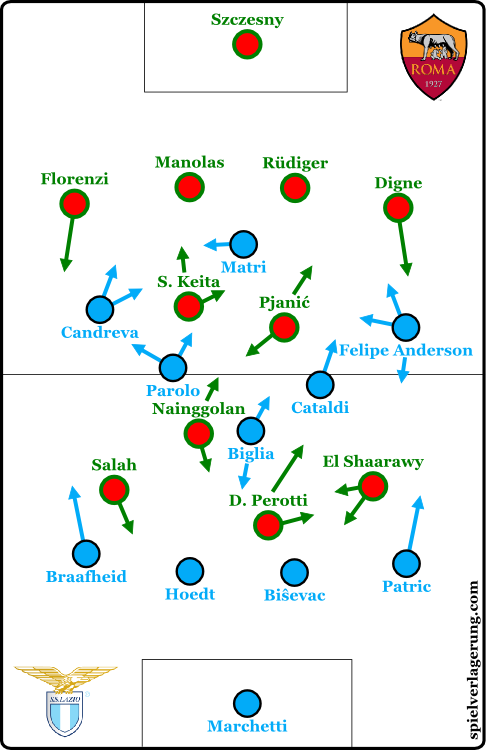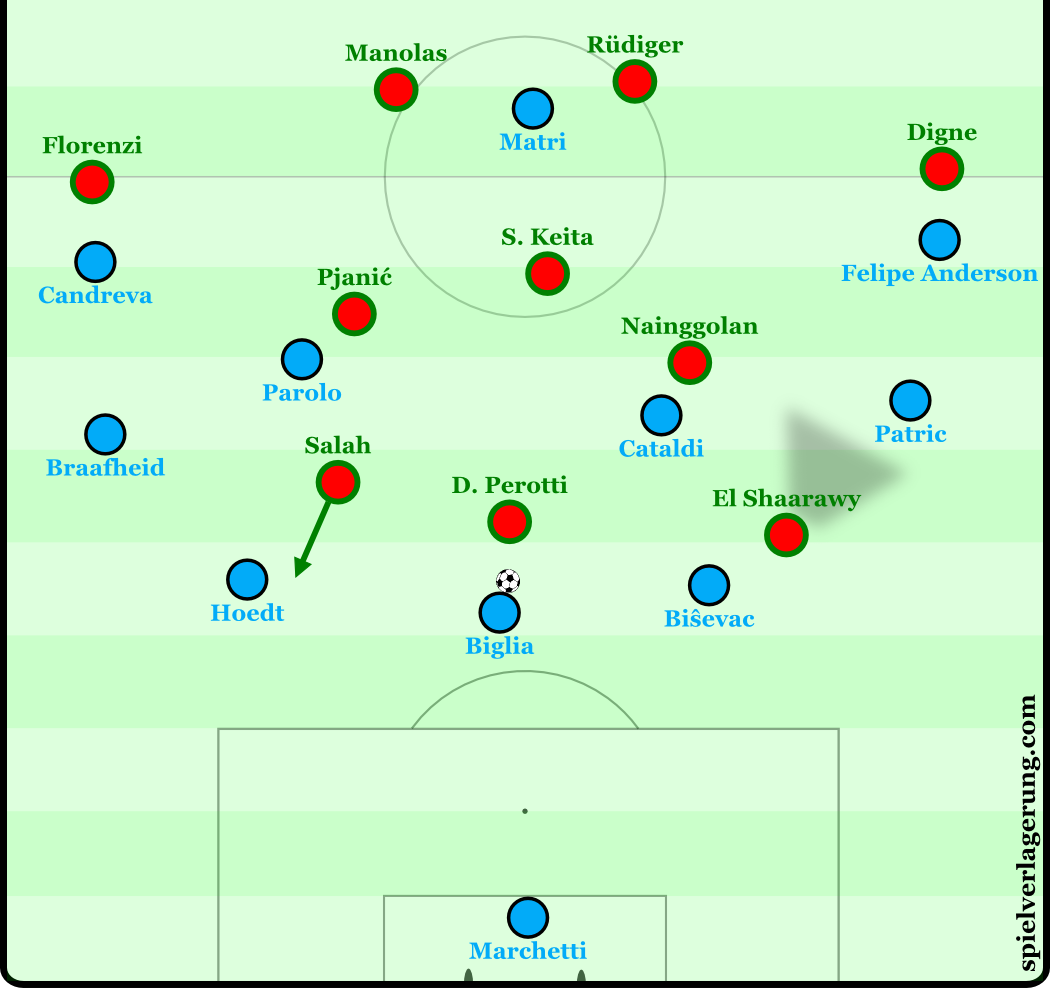Lazio – Roma 1:4
Luciano Spalletti’s Roma side continued their tradition of producing results against Lazio in the Derby della Capitale. An impressive Giallorossi’s display also cost Lazio coach Pioli’s job. The victory for Roma wasn’t a surprise and came after a derby in which both teams developed some interesting interactions.
 Given the high amount of injuries, Stefano Pioli changed Lazio’s shape massively. He employed a 4-3-3 system, with Wesley Hoedt and Milan Biševac playing in the middle of the defence. Both Marco Parolo and Danilo Cataldi were fielded in central midfield, alongside deep-lying playmaker Lucas Biglia.
Given the high amount of injuries, Stefano Pioli changed Lazio’s shape massively. He employed a 4-3-3 system, with Wesley Hoedt and Milan Biševac playing in the middle of the defence. Both Marco Parolo and Danilo Cataldi were fielded in central midfield, alongside deep-lying playmaker Lucas Biglia.
Spalletti lined up his usual starting XI featuring Alessandro Florenzi and Lucas Digne as full-backs, with Miralem Pjanic and Seydou Keita as central midfielders and Diego Perotti as ‘false nine’.
Lazio’s slow passing game
Lazio struggled to move the ball forward, because their formation appeared too rigid. Their passing also was too slow and unable to get through Roma’s compact formation. To overcome Roma’s initial pressing, Lazio utilized Biglia as the Argentine midfielder dropped back into a clear three-man backline as part of Biancocelesti’s La salida lavolpiana.
It didn’t work and Lazio came to play a dreadful and useless tiki-taka U-shape, moving the ball from the backline, to Biglia, to the backline again. Their aim to find gaps high up the pitch and then play quick combinations was completely ineffective due to Roma’s brilliant coverage in their defensive structure.
Lazio rarely found spaces against Roma’s pressing shape. So they were forced to play many dirty passes or act out from unfavourable situations play. This was associated with the erratic movements of their players. Although Cataldi and Parolo was widely actives through the game, both was too often individualists in their movements. It means there was a lack of coordination between the potentially opening spaces and the movements of both the ball and the offensive players.

They were also unable to connect the midfield with the attack. It was due to the deep positioning pf Matri, who acted too much passively and was outplayed by Roma‘s centre-backs.
In the second half, they brought on Keita Balde at left-midfield, with Klose also inserted to play as centre forward. Those changes had effect as Lazio did become more dangerous getting more space in the final third. Pioli identified right-back Florenzi as the weakest point in Roma’s line-up, so his team tried to play Keita Balde through Florenzi’s side. They also started to cross the ball into the area more as the game went on. It was a more effective strategy considering both Klose’s ability when it comes to manage crosses and Wojciech Szczesny weakness when coming out of off the posts. In principle, moving the team higher up bother Roma’s structure and forced them to play more long balls than before.
Unfortunately for the Biancocelesti, it was enough just to cut Roma’s lead to 1-2, but not enough to tie.
Without the ball, Lazio sat back. Their defensive plan, however, didn’t work, as Lazio lacked of compactness. It was particularly true against Roma’s counterattacking play, as Lazio played a high defensive without great vertical compactness and with the whole midfield unable to cover the space between the defence and midfield.
Playing a high defensive line with no central compactness is a very risky strategy against any team, especially against one with the ball-playing ability and the speed of Roma. Against the Giallorossi, the space in between the centre-backs and central midfielders is vital to protect. Lazio didn’t it and Roma found easy to move the ball through Lazio’s midfield.
Roma style of play and structure
The key to Roma’s effective offensive style is an efficient positional structure when in possession. They deploy a quick passing tempo in the middle and in the final third.
As usual under the new regime, Roma overloaded the middle of the field with Perotti coming very deep in possession. This provided stability in the middle and – with Candreva and Felipe Anderson committed to cover Spalletti’s fullbacks – allowed Roma to play a square midfield featuring Perotti, Nainggolan, Pjanic and Keita against Lazio’s 3-man midfield.
Rudiger was vital in their build-up play as they used German defender to dominate the left half-space in early possession, wrecking the already weak Lazio’s central compactness and also giving Roma’s midfielders access to the ball in the middle of the field.
Spalletti also used his fullbacks as offensive weapons. He used both Florenzi and Digne to provide width, but also to push back both Candreva and Felipe Anderson.
Roma’s pressing was effective too. To achieve this they make use of a ball-orientation pressing which resulted in a mid-block able to contain Lazio’s attempts to get the ball in between the lines. Perotti was outstanding without the ball. Rome’s ‘false nine’ restricted Lazio’s access to Biglia, covering him closely. It allowed Nainggolan, Pjanic and Keita to outnumber Parolo and Cataldi.
The basic 4-2-3-1-0 structure slightly went towards a 4-4-2-0, as Nainggolan moved higher alongside Perotti to generate pressure on the opposing first building line. Due to the good pressing structure succeeded, Lazio rarely played the ball through Roma’s midfield.
As pointed earlier, Giallorossi suffered just in the first part of the second half, following Pioli’s introduction of Klose and Keita Balde. Spalletti improved Roma’s wide coverage by bringing on Ervin Zukanović as centre-back, moving more defensive-oriented Rudiger to right fullback while Florenzi was pushed higher up as right-winger.
Conclusion
Roma are currently playing some of the most exciting Serie A football and are now just four points behind 2nd placed Napoli. They are good moving the ball but are even better when they can play their speedy, effective, counterattacks. Spalletti will be encouraged by his side’s performance and tactics.
That said, Roma need to be more clinical as they missed a lot of good opportunities. They also need to increase their depth at the defence in the next summer in order to come closer to Juventus next campaign. A better goalkeeper is a priority as Szczesny once again showed his fragility when coming out of his net as he showed allowing Lazio’s goal.
On the other hand, Lazio was unable to match Roma tactically and their style was not effective. They added another low point to a season which is a mess. Their coach Pioli was sacked following this defeat. Lazio really need to improve their attacking structure under next coach Simone Inzaghi.
Michele Tossani regularly writes for Futbol Tactico and MartiPerarnau.com. Follow him on Twitter @MicheleTossani





Keine Kommentare vorhanden Alle anzeigen